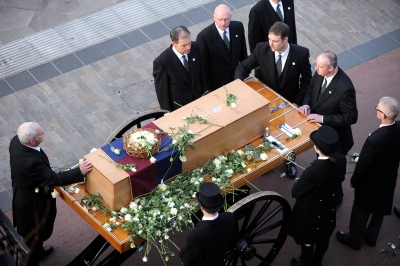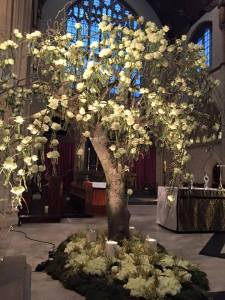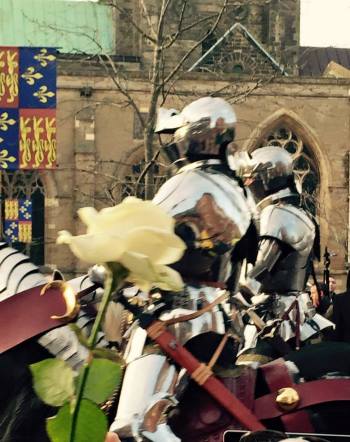 It was today, 532 years ago. What, you may wonder. It was on this day that Richard, Duke of Gloucester took control of his 12 year old nephew, the new king Edward V.
It was today, 532 years ago. What, you may wonder. It was on this day that Richard, Duke of Gloucester took control of his 12 year old nephew, the new king Edward V.
After finding out about his death April 14th, Edward, who had his household in Ludlow, under the charge of his maternal uncle, Anthony Woodville, Earl of Rivers, assembled the King´s escort on April 23rd and the following days started the journey towards London.
Apart from the King himself, Rivers, the King´s tutor, Bishop Alcock, his servant Vaughan and Sir Richard Haute, there was 2 000 men travelling along Watling Street, the old Roman (originally Briton) road which stretches from the borders between Wales and England down towards Canterbury and Dover. By then the King´s older half-brother, Richard Grey, had arrived from London, bearing the urgent request from their Mutual mother, the former Queen Elizabeth Woodville – now in sanctuary in Westminster Abbey – to press on towards London.
Haute, there was 2 000 men travelling along Watling Street, the old Roman (originally Briton) road which stretches from the borders between Wales and England down towards Canterbury and Dover. By then the King´s older half-brother, Richard Grey, had arrived from London, bearing the urgent request from their Mutual mother, the former Queen Elizabeth Woodville – now in sanctuary in Westminster Abbey – to press on towards London.
After the arrival of Grey, he and Rivers rode on to the neighbouring village of Stony Stratford which is located fourteen miles further south. According to legend, Rivers commandeered the inn the Rose and Crown for his young master, and house that still stand and most likely would have stories to tell, could it speak. Having the King settled for the night,  Rivers returned to Northampton while Grey stayed with the King. By now the Duke of Gloucester and the Duke of Buckingham was waiting in Northampton, most likely angered by the fact that the King was gone, but keeping up appearances. There, on April 29th, they spent what has been passed down through history as a pleasant dinner and evening together.
Rivers returned to Northampton while Grey stayed with the King. By now the Duke of Gloucester and the Duke of Buckingham was waiting in Northampton, most likely angered by the fact that the King was gone, but keeping up appearances. There, on April 29th, they spent what has been passed down through history as a pleasant dinner and evening together.
What did they talk about? Someone once said in relation to history that reading it, studying it and researching it is like watching people through a thick pane of glass. You can see them talking, but you will rarely ever know, or find out, what they were actually saying. Much of the sources existing suggests that there already existed a conflict between Richard and Anthony Woodville, the former having been named Lord Protector during the King´s minority, and Anthony Woodville, having been able to form the King´s mind and affection since Edward set up his own household.
But at the same time, Richard of Gloucester and Anthony Woodville had a history together. Not least had they been exiled together during the rebellions of Warwick and George of Clarence. I would say that being privy to the conversations, and the thoughts of the men present would be a dream to many. Because it would soon start, the initial phase of what would lead to one of the great mysteries in English history – the disappearance of the Princes in the Tower – and the ground stone of the reputation of Richard III, this evening still Richard, Duke of Gloucester, would be laid.
Regardless of what was said in the evening, the next morning, April 30th, all joviality that may have existed the previous night was gone. According to Thomas More, who obviously wasn´t present and who had been born only five years before the actual events (but no doubt had access to credible sources when writing his chronicle), Gloucester, Buckingham and a ducal councillor from the north where Gloucester had his power base, Richard Ratcliff, had been up late the previous evening, long after Rivers had retired to bed, discussing more of what is now unknown to us.
The chronicler Polydore Vergil states that it was “commonly believed” that Richard´s plans to usurp the throne was already well on the way by now, and that it had already taken form when the news of his brother´s death. This is also stated by both More and the Croyland chronicle.
already well on the way by now, and that it had already taken form when the news of his brother´s death. This is also stated by both More and the Croyland chronicle.
When Anthony Rivers woke up, it was to find himself under arrest. The two Dukes had pressed on to Stony Stratford, where they fell on their knees for their King. The vail would soon fall, however, as also Richard Grey was arrested, and the King´s retinue was dismissed. And there he was, a 12 year old boy, deprived of those he knew well, in the hands of an uncle he hardly knew at all, as Richard had spent most of his time in the north.
The young King wouldn´t see his uncle or half-brother again. Both Rivers and Grey would be brought to the north for imprisonment and would during the following months have their lands redistributed to other nobles, more to Richard´s liking. They were both beheaded at Pontefract Castle on June 25th that same year, whether they received a trial is often debated.
Young King Edward V was brought to London to be crowned King, something that was never to happen. Like other Kings, he was taken to the Tower to await his coronation, but unlike them all, he was never to emerge from there again.
Souces:
The Princes in the Tower – Alison Weir
The Croyland Chronicles
The History of King Richard III – Sir Thomas More
Images:
Pontefract Castle – Tim Green
 Northamptonshire.
Northamptonshire.
























